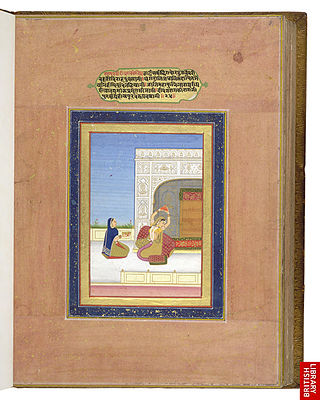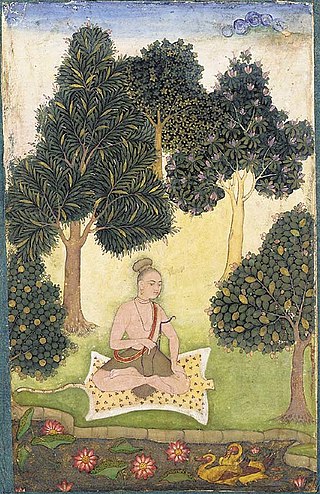Related Research Articles

Madhuvanti is a raga used in Indian classical music. It is a Hindustani music raga, which is reported to have been borrowed into Carnatic music, and is structurally similar to Multani.

Atana or AThana is a raga in Carnatic music. It is a Janya raga, whose Melakarta raga is Sankarabharanam, 29th raga, commonly known as Shankarabharanam in the Melakarta system. Sometimes pronounced aDaaNaa (अडाणा). There is a Hindusthani raaga named अडाणा, which is totally different.

Raga Ramkali is a raga in Hindustani classical music and can be themed around soothing things a man would say to please a discontent wife, it is an early morning raga belonging to Bhairav Thaat. In this raga, as in Bhairav, Rishabh and Dhaivat are Komal(flat), but the Teevra and the flat nishad are added. The vadi-samvadi are Pancham and Shadja. The aroha is S r G M P, G M d N S' and the avroha is S' N d P m P, d (N)d P, G M r S. Flat nishad and sharp madhyama are used often.
Raga Malgunji is a Hindustani classical raga from the Khamaj Thaat. Some say it is a part of the Kafi Thaat too.
Arohana, Arohanam, Aroh or Aroha, in the context of Indian classical music, is the ascending scale of notes in a raga. The pitch increases as we go up from Shadja (Sa) to the Taar Shadja (Sa), possibly in a crooked (vakra) manner.
Darbari Kanada, or simply Raga Darbari, is a raga in Carnatic music. It is a janya ragam of 20th Melakarta raga Natabhairavi. Being an ancient raga, its original name is unknown. It is believed to be borrowed into Hindustani classical music by Miyan Tansen, the famous 16th-century composer in emperor Akbar's court. It belongs to the Kanada family. This tradition is reflected in the name itself; Darbar is the Persian derived word in Hindi meaning "court." As the most familiar raga in the Kanada family, it may sometimes also be called Shuddha Kanada or pure Kanada. It belongs to the Asavari thaat. This raag is called raaga Kaanada in Yakshagana Karnataka state dance. It is also sometimes written as Durbari and Durbarikanada.

Bhairavi is a Hindustani Classical heptatonic (Sampurna) raga of Bhairavi thaat. In Western musical terms, raga Bhairavi employs the notes of the Phrygian mode, one of the traditional European church modes.
Raga Bageshri or Bageshree is a Carnatic classical raga. It is a janya raga of the 22nd Melakarta raga Kharaharapriya. It is meant to depict the emotion of waiting for reunion with one's lover. Being a very melodic raga it has gained popularity over the centuries. In Hindustani music, it is said to have been first sung by Miyan Tansen, the celebrated court singer of the Emperor Akbar in the sixteenth century.

Abhogi is a raga in Carnatic music and has been adapted to Hindustani music. It is a pentatonic scale, an audava raga. It is a derived scale, as it does not have all the seven swaras. Ābhōgi has been borrowed from Carnatic music into Hindustani music and is also quite popular in the latter. In Hindustani music the raga has been classified under the Kafi thaat.
Bahar is a Hindustani classical raga. This raga is very similar to raga Malhar. This raga is from the Kafi Thaat.
Bhimpalasi or Bheempalasi is a Hindustani classical raga. The Carnatic Music equivalent of this raga is Abheri.

Kafi is a raga in Hindustani classical music. It corresponds to Kharaharapriya in Carnatic music and Dorian mode in Western music
Pilu or Peelu is a raga of Hindustani classical music. It is mostly used in light-classical forms, like thumris.

Purvi or Poorvi is a raga in Hindustani classical music that exemplifies its own thaat, the Poorvi thaat. Purvi has a deeply serious, quiet and somewhat mystical character. It is uncommon in performances nowadays.

Miyan ki Todi, often simply referred to as Todi or Darbari Todi, is a Hindustani classical raga which gave its name to the Todi thaat, one of the ten types of classical music according to the musicologist Bhatkhande. Ragas from the Todi raganga include Todi itself, Bilaskhani Todi, Gujari Todi, Desi Todi, Hussaini Todi, Asavari Todi, and Bahaduri Todi.

Sindhu Bhairavi is a raga in Hindustani and Carnatic classical music, belonging to the Asavari thaat. In Carnatic music it is a Janya raga of the 8th melakartha raga Hanumatodi.

Raga Kedar, also known as Kedara, is a Hindustani classical raga. Named after Lord Shiva, the raga occupies a high pedestal in Indian classical music. It is characterised by many melodious turns. This raga is the repetition of the swaras सा and म. It is generally accepted that it displays much thermal energy and is regarded as the Raagini of Raag Deepak. While preceding from Shuddha Madhyam (m) to Pancham (P), a touch of Gandhar (G) or a smooth passage from Gandhar (G) to Pancham (P) expressed as m G P is the more common way of instant raga manifestation.

Khamaj is one of the ten thaats of Hindustani music from the Indian subcontinent. It is also the name of a raga within this thaat.
Gaud Sarang is a raga in Hindustani classical music that combines characteristics of Sarang and the now extinct raga named Gaud. Unlike most other members of the Sarang family of ragas, Gaud Sarang is assigned to the Kalyan thaat rather than the usual Kafi.
Gara is a Hindustani classical raga belonging to the Khamaj Thaat. This raga is similar to raga Jaijaiwanti. Both ragas i.e. raga Jaijaiwanti and raga Gara, have the same svaras. Gara is a rare raga. It is rendered in the late evening. The raga uses all the seven notes, six in the ascent and seven in the descent. Therefore, the Jati of the raga is Shaadav-Sampurna. While some say that seven svaras are played in the ascent and seven in the descent. Therefore, the Jati then becomes Sampurna-Sampurna. It uses both, the Komal (flat) and Shuddha (full) Nishad, and all other notes are Shuddha (full). The derivative ragas out of this structure are grouped under the broad head of Khamaj Thaat. Gara belongs to a family of melodic entities, which were apparently derived from folk melodies, and entered art-music in association with the thumri genre. This family includes ragas like Kafi, Piloo, Jangula, Barwa, and Zilla, along with several others. This raga expresses the feeling of happiness and satisfaction of achievement, however it simultaneously conveys the sadness of losing. This raga is also a vivacious and romantic one.